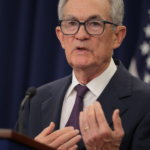Despite little change in the U.S. stocks on Wednesday, investors watched the markets closely.
The S&P 500 closed the day just 51 points off from its all-time high closing price of 6,144 on February 19.
The fact U.S. equities are not just recovering from their April rout, but rebounding to the record highs they saw before President Donald Trump’s tariff policies, indicates markets may have started readjusting to the era of increased uncertainty investors find themselves in.
On Wednesday oil futures were up 1.4% after falling earlier this week.
Stocks also saw a similar drop earlier this week. After Monday’s initial shock, a muted and fairly surprising reaction followed, noted Jake Schurmeier, portfolio manager at Harbor Capital and a former member of the Federal Reserve Bank of New York’s Markets Group.
“The risk premium in markets lasted all of five hours,” Schurmeier told Fortune. “I think the answer could be that markets are becoming more efficient in getting used to these geopolitical blips.”
The ups and downs of the last few days pointed to a reactionary market, Schurmeier said.
“The broader point is we’ve become so short term,” he said. “It all strikes me as very cynical and short-term thinking at this point.”
With choppy markets, including in intraday trading, some investors keep an eye on the long game. Bob Robotti, president and chief investment officer of asset manager Robotti & Company, said he’s focused on the structural risks facing the economy rather than short-term geopolitical volatility.
For instance, several major forces are going to drive inflation higher, he said. Key inflationary pressures such as “all the aspects of tariffs, changing supply chains, extra frictional costs” aren’t temporary but represent fundamental shifts in how the global economy operates, Robotti said. He sees the outcome from those shifts resulting in permanently higher prices.
“If inflation is a persistent event and higher interest rates are required, that means lower multiples on everything in the investable world,” Robotti told Fortune. “This is particularly concerning given the concentration of capital in growth assets and private equity that have benefited from the low-rate environment, making the entire system more vulnerable to an inflationary regime change.”









